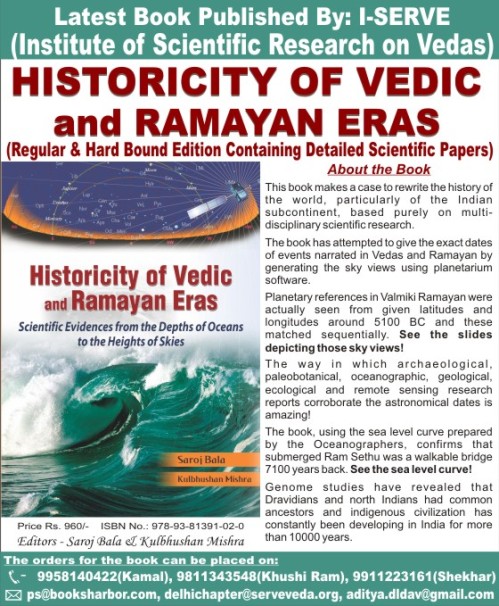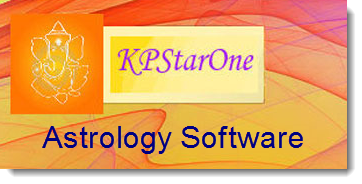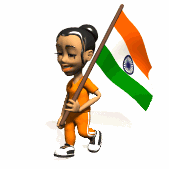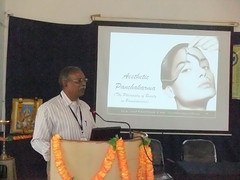 I-SERVE Delhi Chapter undertook a R&D project on the Scientific Dating of Ancient Events from Rigveda to Aryabhatiam, as National Seminar on “Scientific Dating of Ancient Events Before 2000 BC” held on 30th & 31st July, 2011, which had two parts:
I-SERVE Delhi Chapter undertook a R&D project on the Scientific Dating of Ancient Events from Rigveda to Aryabhatiam, as National Seminar on “Scientific Dating of Ancient Events Before 2000 BC” held on 30th & 31st July, 2011, which had two parts:
- To ascertain astronomical dating of planetary references in ancient Sanskrit manuscripts by making use of planetarium software.
- To correlate such astronomical dates with corroborating archaeological, geological,anthropological, paleobotanical, oceanographic, ecological and remote sensing evidences.
Till now we have been told that prior to 1500 BC,Indiawas uncivilized and that the Aryans, who came fromCentral Asia, pushed the uncivilized inhabitants towards the south, who later came to be known as Dravidians. We are also told that these invaders were the ones who set up the first civilized society inNorth India. Multidisciplinary and purely scientific research has shown that this premise, which was based on linguistic guesswork, is not correct. Scientific evidences from different sources and research studies have revealed that indigenous civilisation has been developing inIndiafor last 10000 years and many of the events mentioned in Vedas and Epics appear to be true and are capable of being scientifically dated.
The premise on which this seminar was organized was that 99% of the research outcomes being presented during the Seminar were not known to 99.9% of Indians. Therefore many questions already agitating their minds and those raised during the deliberations at the seminar were answered on the following lines by the experts/scientists on the basis of the latest scientific research reports:
- The astronomical dates of planetary references in ancient books calculated by the eminent astronomers by making use of planetarium software, indicate the development of an indigenous civilization in India from dates even prior to 6000 BC. Astronomical references in Rigveda represent the sky view of dates belonging to the period from 8000 BC to 4000 BC and those mentioned in Ramayan refer to sky views seen sequentially on dates around 5000 BC. These dates are exclusive and match sequentially.
- The ecological references in ancient books, especially those relating to melting of glaciers and fluctuations in water volumes of ancient rivers, seem to corroborate such astronomical dates. Recent research reports on paleoclimatic changes have revealed that, after the last ice age and in the beginning of the Holocene, the glaciers first melted near the equator i.e. in south India, and civilisation started developing on the Banks of the rivers which started flowing there. When populations multiplied, these river waters became insufficient and some more adventurous people started travelling from south to north. Such northward migration continued for several centuries & finally when these people reached the banks of Himalayan Rivers, they got climatic conditions conducive to long term development of civilisation on the banks of these rivers providing security of water, food & shelter. Thousands of years later, when some of these Himalayan Rivers become non-perennial or started drying up, some of these people moved towards Central Asia andEurope. As per ecologists this ecological cycle has been repeating itself and will get repeated after every ice age.
- Remote Sensing pictures taken by ISRO, corroborated by geological reports, have revealed that a mighty river system, referred to in Vedas and Epics as Saraswati, was flowing with full majesty around 6000 BC. The river slowly dried up and almost disappeared around 3000 BC. These conclusions have been supported by sedimentology, hydrogeology and drilling data. These conclusions not only support the astronomical dates of Vedas and Epics but also support such references in ancient books.
- The oceanographic reports on fluctuations of water levels in the oceans have revealed the existence of many coastal archaeological sites, either submerged or now found land locked, dated from 7500 BC onwards e.g. Hazira, Dholavira, Juni Kuran, Sur Kotda, Prabhas Patan and Dwarka etc. These supported the historicity and dating of many events mentioned in our Epics i.e. submersion of Dwarka in Mahabharata era and use of Ramsetu as land route in Ramayana era.
- The paleobotanical research reports have revealed that certain cultivated varieties of plants, trees and herbs, which are mentioned in Vedas and Epics, have existed inIndiacontinuously for more than 8000-10000 years. Remains of cultivated rice, wheat and barley have been found belonging to 7000 BC; melon seeds, lemon leaf, pomegranate, coconut and date palm etc relating to 4000BC; lentils, millets and peas etc from 3000 BC; use of reetha, anwla and shikkakai for making shampoo since2500 BC. These plants remained in use continuously indicating that there was not any abrupt end of ancient Indian civilisation as is normally being taught in schools and colleges.
- The latest archaeological excavations have revealed large volume of new data which has proved the indigenous origin and development of civilisation in the Indian Subcontinent since 7000 BC. Some examples are: Lahuradeva, Jhusi, Tokwa and Hetapatti in GangaValleyin the east; Mehrgarh, Kot Diji and Nausharo in Indusvalley in the northwest; Lothal and Dholavira in the west. The material testimonies of these excavations have shown gradual cultural developments from the 7th-6th millennium BC in the entire region of Indus-Saraswati-Ganga system for a period of almost eight thousand years. Thus archaeology is also supporting the astronomical, ecological and anthropological conclusions that Aryans were originals of India, they have been creating and nurturing a continuously developing civilisation for last 10000 years and dispersal probably happened the other way round.
- The anthropological research reports have established that DNA dating for paleolithic continuity starts from 60000 BC. The Genome studies during the Holocene have revealed that the genetic profile of humans settled in north, south, east and west of India is the same and has remained the same for the last more than 11000 years. It is also significant to note that the inhabitants of the Harappan civilisation were not a mysterious people of unknown biological origins, or migrants from western/centralAsia, but they were the indigenous people identified with the pre/early Harappan cultures of northwestern region of the Indian subcontinent. Therefore, contrary to the popular belief, the Dravidians as well as north Indians have common ancestors and both are originals ofIndia, have common genetic profile and thus had common ancestors.
They emphasized that all these multidisciplinary scientific research reports, presented during the Seminar, prima facie establish that indigenous civilization has been developing in India for last 10000 years and that all Indians share their genetic profile, therefore, it is time to move away from the linguistic theory of Aryan invasion and raise our heads with pride as nurturers of the oldest civilization in the world.
Sh. Y.K. Gaiha, IRS (Member of BIFR) briefed the participants about the public welfare and business opportunity created by this kind of research and particularly by this National Seminar:
- The presentations during the Seminar have the potential of uniting all Indians by bridging the North-South divide which is based on only linguistic guesswork, having no scientific basis. These also raise their self esteem.
- Focus on harnessing drinkable water underground trapped below dry paleochannels of ancient rivers like Saraswati and Drishadwati can help resolve some of the water-scarcity problems in selected areas of water scarcity.
- Seminar creates huge potential for promoting tourism e.g. if a transparent tube and an underwater museum are created at the site of submerged Dwarka city, the entire cost can presumably be recovered during first one year and tourism in India will enter the next generation facilities.
Further Reading:

































